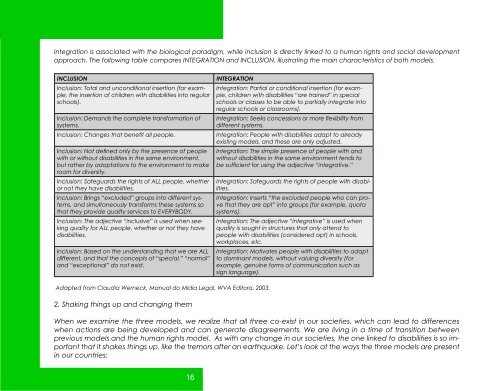in English - Handicap International
in English - Handicap International
in English - Handicap International
You also want an ePaper? Increase the reach of your titles
YUMPU automatically turns print PDFs into web optimized ePapers that Google loves.
Integration is associated with the biological paradigm, while <strong>in</strong>clusion is directly l<strong>in</strong>ked to a human rights and social development<br />
approach. The follow<strong>in</strong>g table compares INTEGRATION and INCLUSION, illustrat<strong>in</strong>g the ma<strong>in</strong> characteristics of both models.<br />
INCLUSION<br />
Inclusion: Total and unconditional <strong>in</strong>sertion (for example,<br />
the <strong>in</strong>sertion of children with disabilities <strong>in</strong>to regular<br />
schools).<br />
Inclusion: Demands the complete transformation of<br />
systems.<br />
Inclusion: Changes that benefit all people.<br />
Inclusion: Not def<strong>in</strong>ed only by the presence of people<br />
with or without disabilities <strong>in</strong> the same environment,<br />
but rather by adaptations to the environment to make<br />
room for diversity.<br />
Inclusion: Safeguards the rights of ALL people, whether<br />
or not they have disabilities.<br />
Inclusion: Br<strong>in</strong>gs “excluded” groups <strong>in</strong>to different systems,<br />
and simultaneously transforms these systems so<br />
that they provide quality services to EVERYBODY.<br />
Inclusion: The adjective “<strong>in</strong>clusive” is used when seek<strong>in</strong>g<br />
quality for ALL people, whether or not they have<br />
disabilities.<br />
Inclusion: Based on the understand<strong>in</strong>g that we are ALL<br />
different, and that the concepts of “special,” “normal”<br />
and “exceptional” do not exist.<br />
INTEGRATION<br />
Integration: Partial or conditional <strong>in</strong>sertion (for example,<br />
children with disabilities “are tra<strong>in</strong>ed” <strong>in</strong> special<br />
schools or classes to be able to partially <strong>in</strong>tegrate <strong>in</strong>to<br />
regular schools or classrooms).<br />
Integration: Seeks concessions or more flexibility from<br />
different systems.<br />
Integration: People with disabilities adapt to already<br />
exist<strong>in</strong>g models, and these are only adjusted.<br />
Integration: The simple presence of people with and<br />
without disabilities <strong>in</strong> the same environment tends to<br />
be sufficient for us<strong>in</strong>g the adjective “<strong>in</strong>tegrative.”<br />
Integration: Safeguards the rights of people with disabilities.<br />
Integration: Inserts “the excluded people who can prove<br />
that they are apt” <strong>in</strong>to groups (for example, quota<br />
systems).<br />
Integration: The adjective “<strong>in</strong>tegrative” is used when<br />
quality is sought <strong>in</strong> structures that only attend to<br />
people with disabilities (considered apt) <strong>in</strong> schools,<br />
workplaces, etc.<br />
Integration: Motivates people with disabilities to adapt<br />
to dom<strong>in</strong>ant models, without valu<strong>in</strong>g diversity (for<br />
example, genu<strong>in</strong>e forms of communication such as<br />
sign language).<br />
Adapted from Claudia Werneck, Manual do Midia Legal, WVA Editora, 2003.<br />
2. Shak<strong>in</strong>g th<strong>in</strong>gs up and chang<strong>in</strong>g them<br />
When we exam<strong>in</strong>e the three models, we realize that all three co-exist <strong>in</strong> our societies, which can lead to differences<br />
when actions are be<strong>in</strong>g developed and can generate disagreements. We are liv<strong>in</strong>g <strong>in</strong> a time of transition between<br />
previous models and the human rights model. As with any change <strong>in</strong> our societies, the one l<strong>in</strong>ked to disabilities is so important<br />
that it shakes th<strong>in</strong>gs up, like the tremors after an earthquake. Let’s look at the ways the three models are present<br />
<strong>in</strong> our countries:<br />
16

















